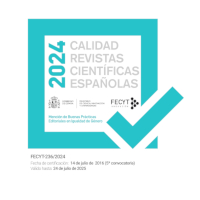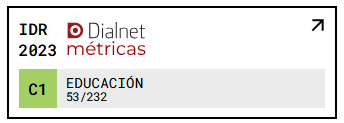Linguistic analysis of two co-educational guides
DOI:
https://doi.org/10.18172/con.5416Keywords:
Coeducation, text and content analysis, linguisticsAbstract
The variety of guidelines used in education has sparked our interest to analyze them, in particular those developed for co-educational contexts. To begin with, we will define the textual genre to be analyzed. Then, we will examine the content of two guidelines and their linguistic approach, or, in other words, the linguistic forms through which content is expressed: the discourse types covered in the guidelines and the voices and modalization shown. The guideline content is written from a neutral writer perspective, typical of academic texts, with a clear presence of the female writers' voices. There is use of grammatical forms marked for feminine gender case in contrast with the common use of the male gender case in our society. In the guidelines, the theoretical discursive type is predominant, combined with segments of the interactive discourse. We believe that the latter enables the social purpose of this type of documents, that is, setting in motion and involving the target readers.
Downloads
References
Asociación de Madres Solas (AMASOL) (2018). Aprendiendo a ser iguales. Manual de coeducación en igualdad de género. Instituto Aragonés de la Mujer.
Bronckart, J. P. (1997/2004). Actividad verbal, textos y discursos. Por un Interaccionismo socio-discursivo. Fundación Infancia y Aprendizaje.
Bronckart, J. P. (2007). Desarrollo del lenguaje y didáctica de las lenguas. Miño y Dávila.
Delors, J. (1996). La educación encierra un tesoro. Informe a la UNESCO de la Comisión internacional sobre la educación para el siglo XXI. Santillana/UNESCO.
Federación de Mujeres Progresistas (FMP) (2018). Guía de buenas prácticas coeducativas. Ministerio de Sanidad, Servicios Sociales e Igualdad.
Fumero, K., Moreno Llaneza, M. y Ruiz Repolludo, C. (2016). Escuelas libres de violencias machistas. Universitat de les Illes Balears.
Galdo, J. M. (2019). La importancia de la coeducación para el logro de la igualdad. Fórum Aragón, 26, 16-19.
Goicoechea, M. V. y Goicoechea, M. Á. (2019). Enseñar la lengua con perspectiva de género, ¿una necesidad actual? Eutomia. Revista de Literatura e Lingüística, 1(23), 299-314. http://doi.org/10.19134/eutomia-v1i23 DOI: https://doi.org/10.51359/1982-6850.2019.240542
Goicoechea, M. Á. y Goicoechea, M. V. (2020). Análisis de la corresponsabilidad en las guías de coeducación. En V. Sánchez, M. T. Bejarano y S. Corral (Coords.), Género e igualdad como señas de identidad modernas (pp. 159-171). Tirant humanidades.
Habermas, J. (1988). Teoría de la acción comunicativa. Taurus.
Habermas, J. (1989). Teoría de la comunicación: Complementos y estudios previos. Cátedra.
López Noguero, F. (2002). El análisis de contenido como método de investigación. XXI, Revista de Educación, 4, 167-179.
Rausell Guillot, H. y Talavera Ortega, M. (2017). Dificultades de la coeducación en la formación del profesorado. Feminismo/s, 29, 329-345. http://doi.org/10.14198/fem.2017.29.13 DOI: https://doi.org/10.14198/fem.2017.29.13
Scott, J. (1996). El género: Una categoría útil para el análisis histórico. En M. Lamas (Comp.). El género: la construcción cultural de la diferencia sexual (pp. 265-302). PUEG.
Tossi, C. (2019). Marcas discursivas de la diversidad. Acerca del lenguaje inclusivo y la educación lingüística: aproximaciones al caso argentino. Álabe. Revista de la Red de Universidades Lectoras, 20, 1-20. http://doi.org/10.15645/Alabe2019.20.11 DOI: https://doi.org/10.15645/Alabe2019.20.11
Downloads
Published
How to Cite
Issue
Section
License
Copyright (c) 2022 María Ángeles Goicoechea Gaona, María Victoria Goicoechea Gaona

This work is licensed under a Creative Commons Attribution 4.0 International License.
The authors retain copyright of articles and authorize Contextos Educativos. Revista de Educación the first publication. They are free to share and redistribute the article without obtaining permission from the publisher as long as they give appropriate credit to the editor and the journal.
Self-archiving is allowed too. In fact, it is recommendable to deposit a PDF version of the paper in academic and/or institutional repositories.












